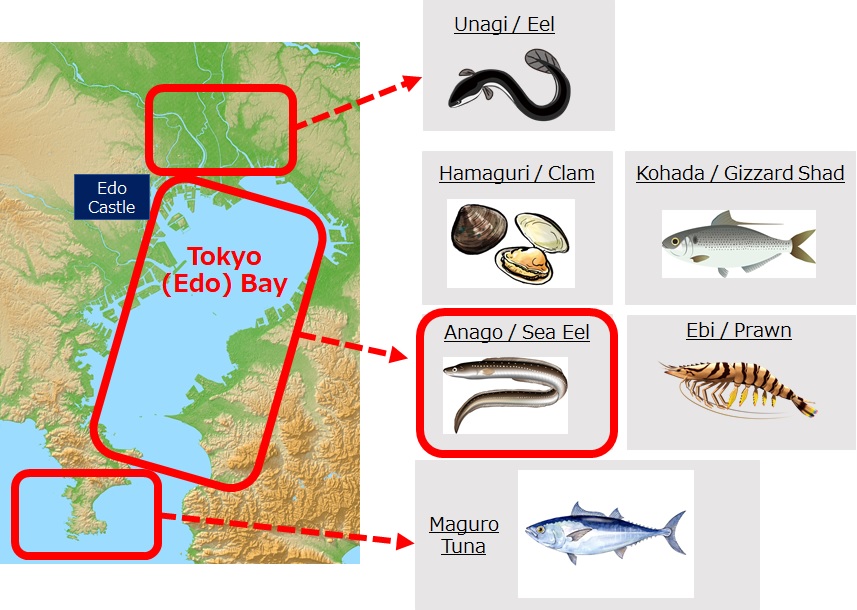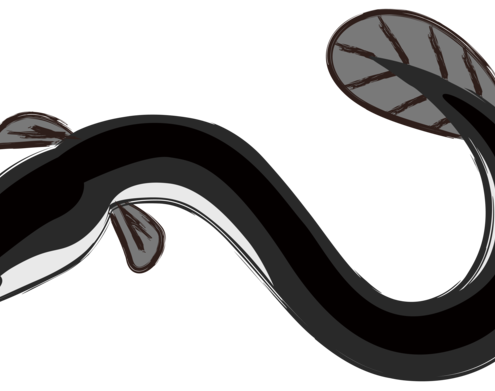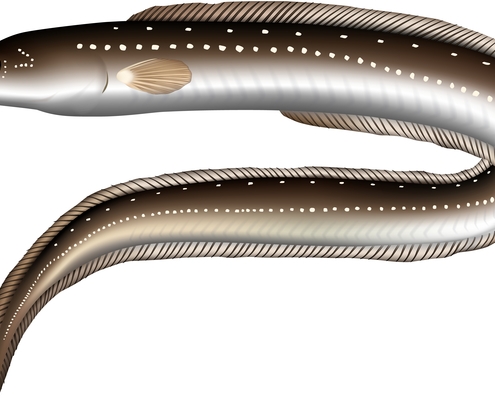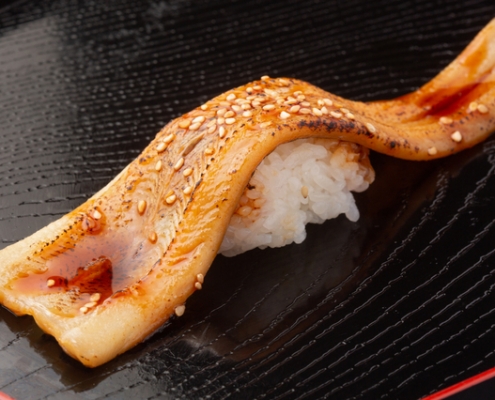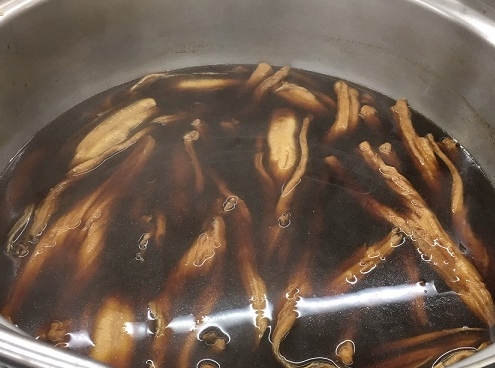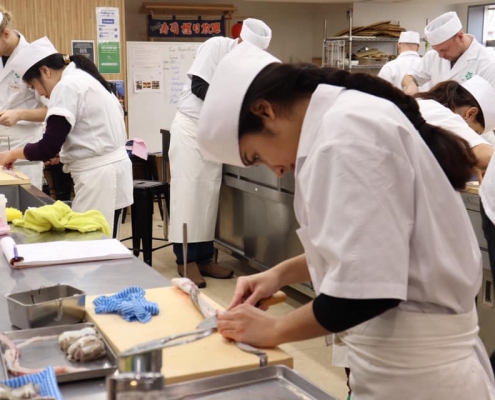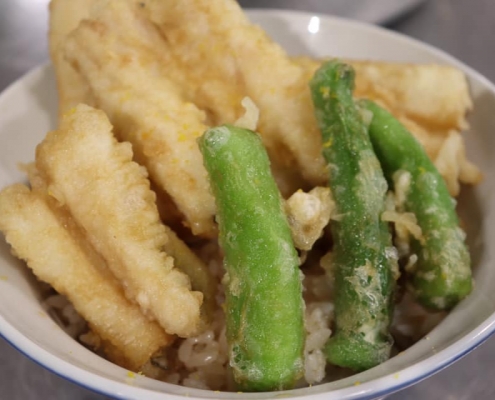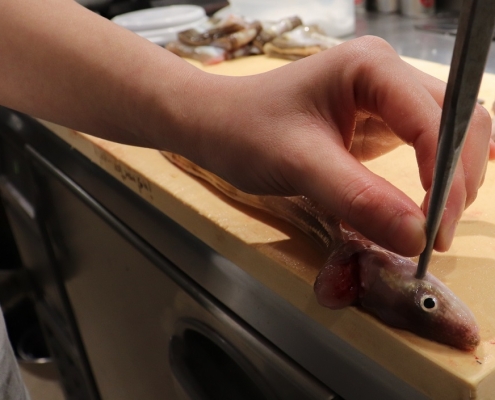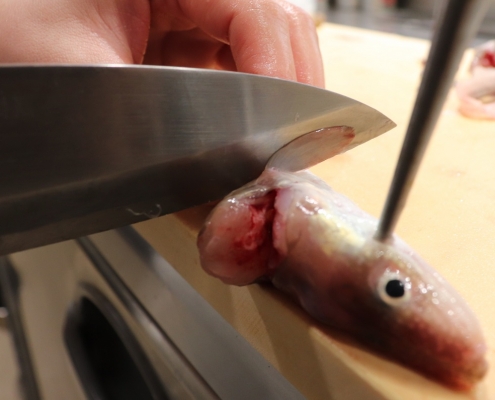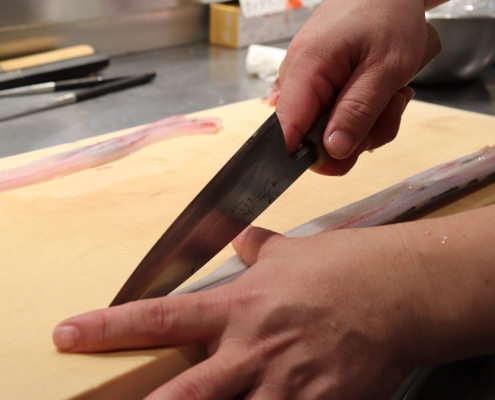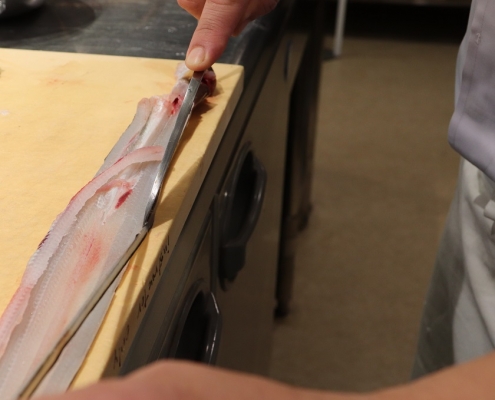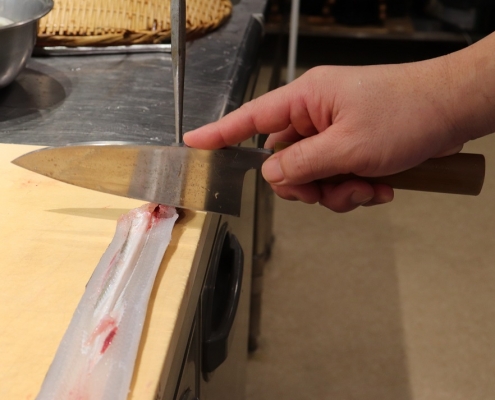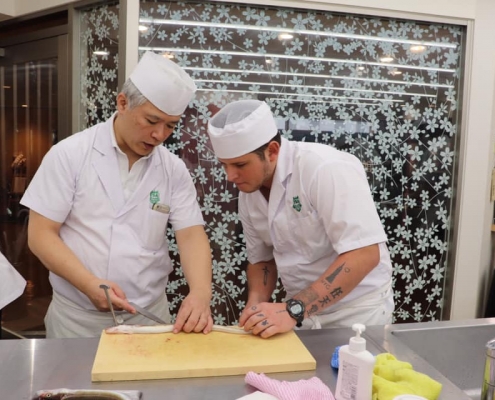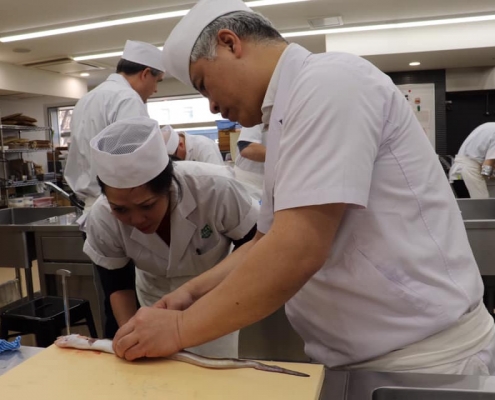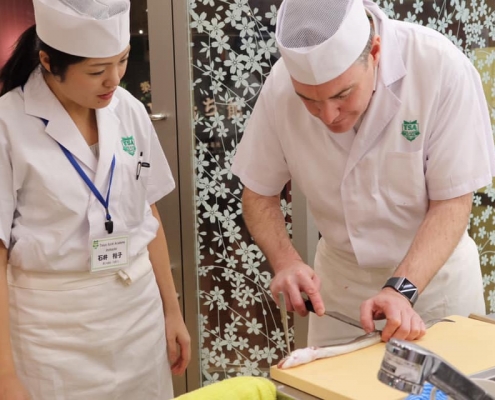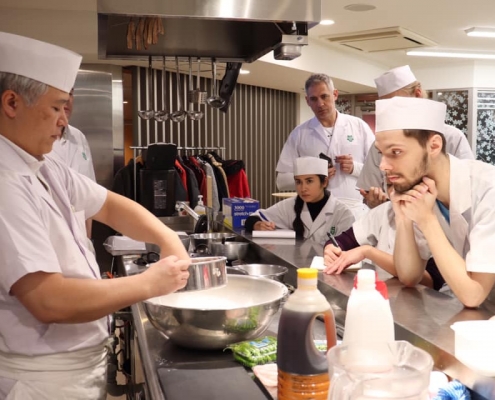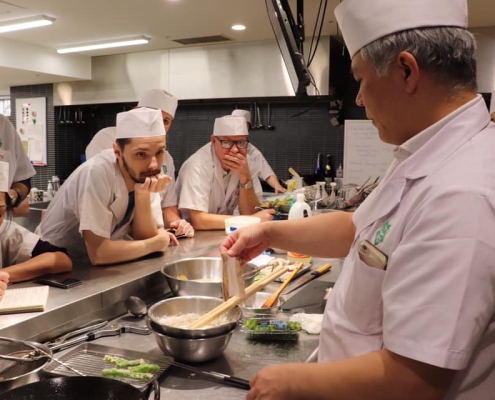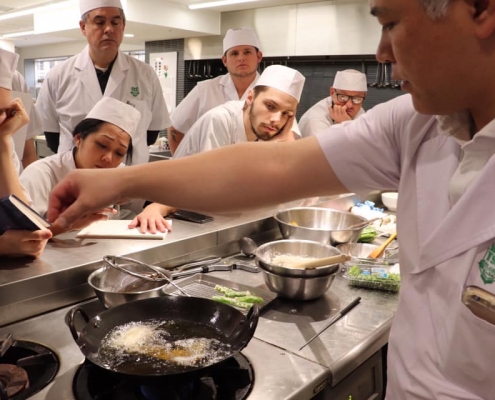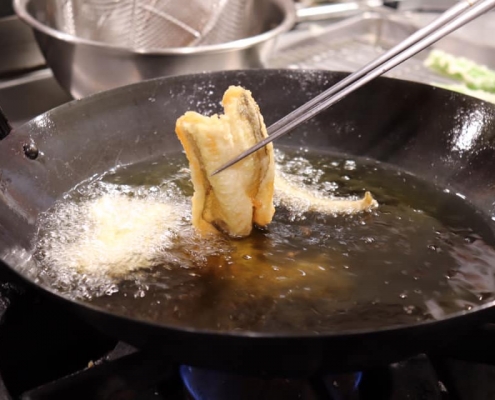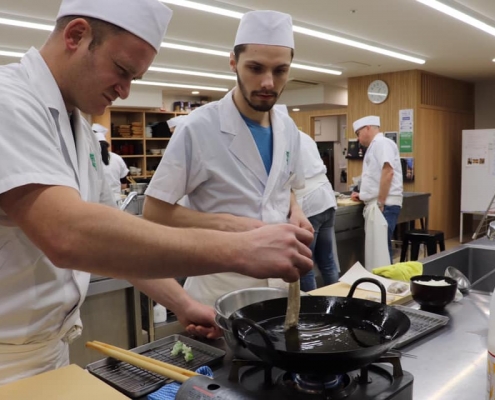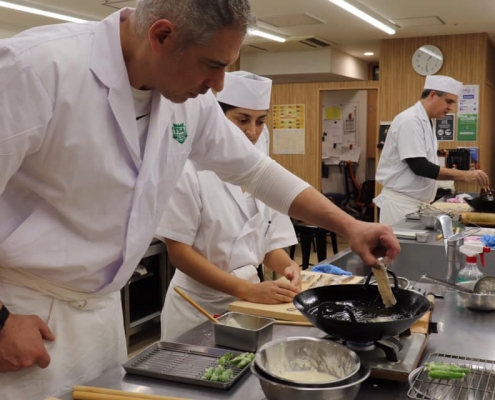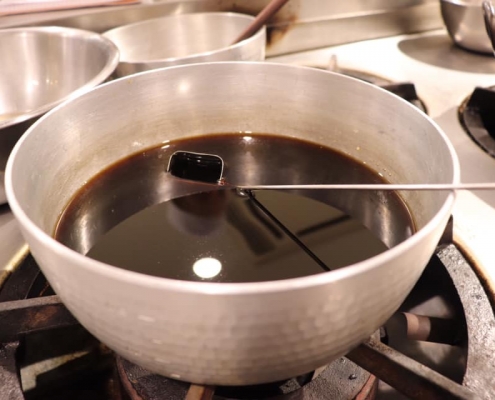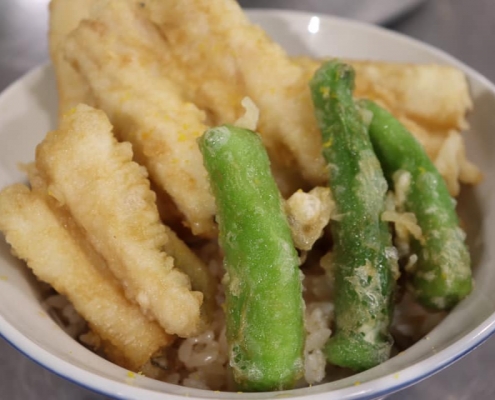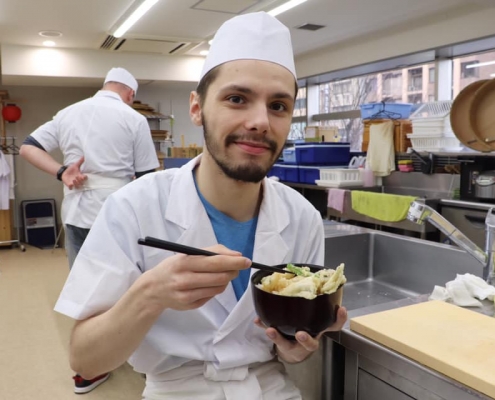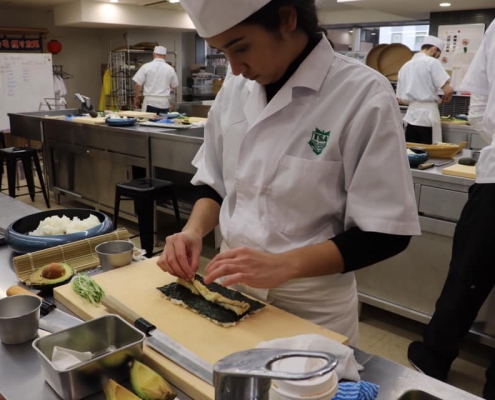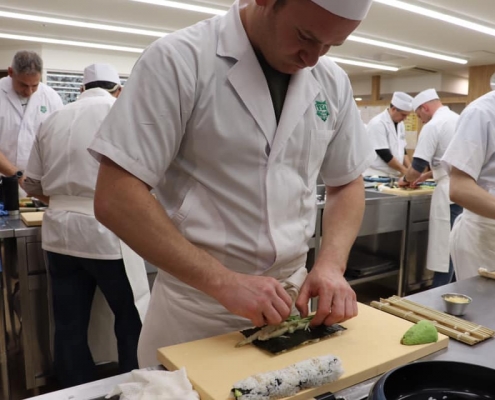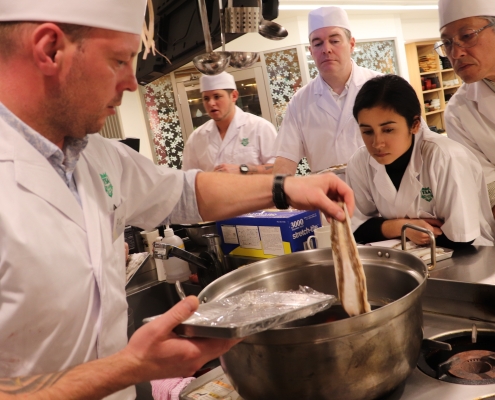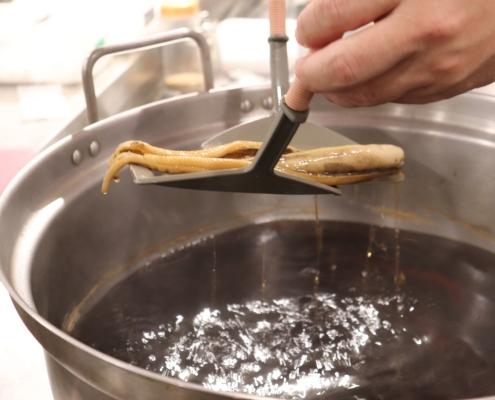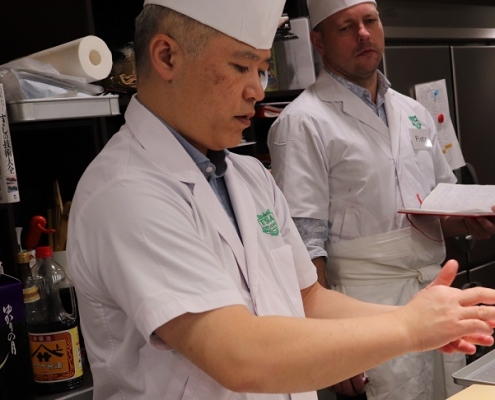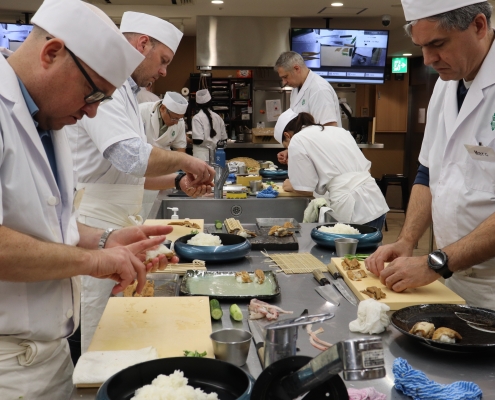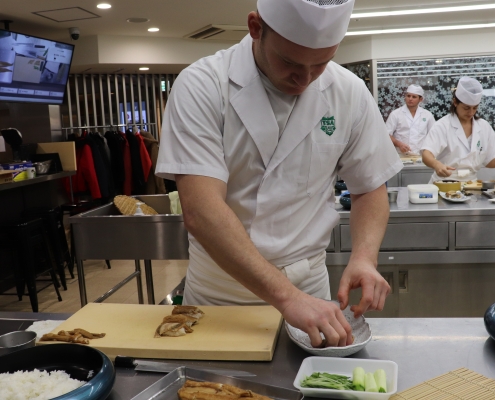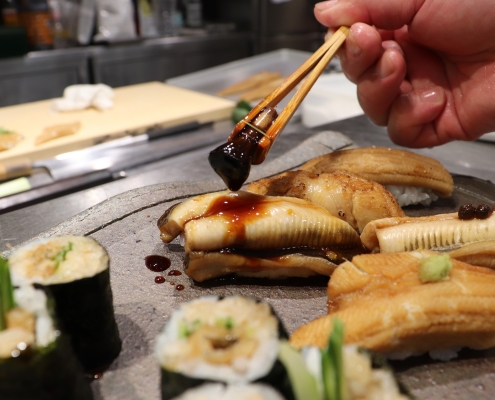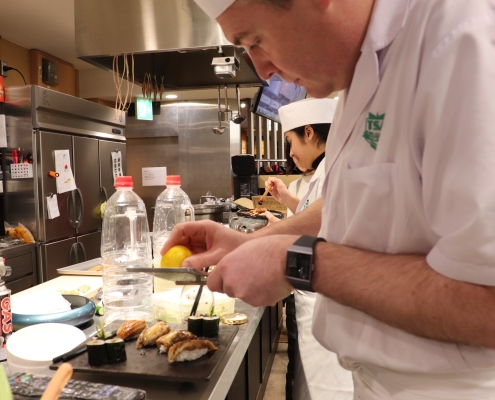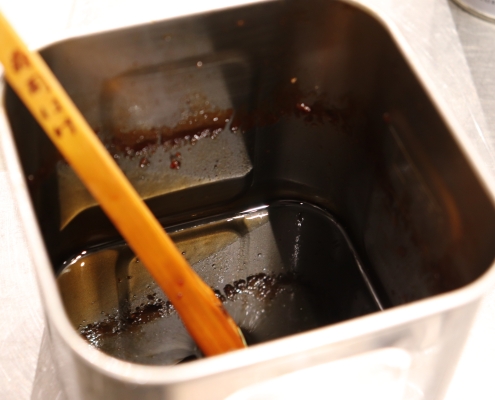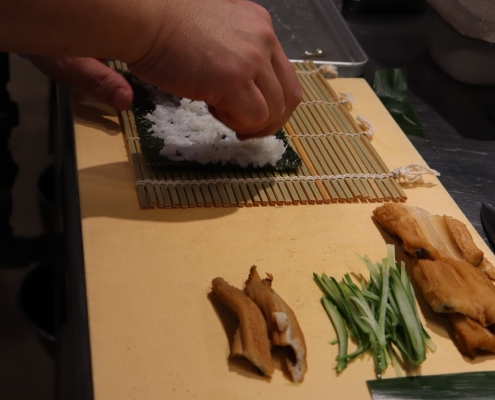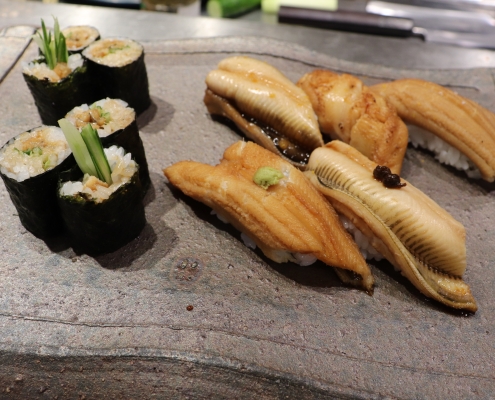Anago Recipe: Sushi, Tempura and more! Learn edomae technique at Tokyo Sushi Academy!
February 6th 2020 Updated
Contents
- 1 Basic Information about Anago
- 2 What ingredients are available in Tokyo bay?
- 3 How to judge the quality?
- 4 Anago seawater eel and Unagi freshwater eel
- 5 Why do Japanese gourmets like anago?
- 6 How much is anago?
- 7 What can I make with anago?
- 8 How to filet anago?
- 9 Anago Tempura
- 10 Caterpillar Rolls with Anago
- 11 Anago Nigiri Sushi
Basic Information about Anago
Anago on average is about 1 meter long. It lives in shallow water less than 100 meters deep, such as the coast or the bay. During the day, Anago hides itself in sand or mud and it comes out at night to search for food, crawling around the bottom of the ocean. “Edomae Anago,” captured in Tokyo Bay, is particularly famous, but you can also find high-quality Anago in Setouchi, Tsushima in Nagasaki, or South Korea.
The best time for Anago is April through August and the peak comes around the rainy season.
What ingredients are available in Tokyo bay?
How to judge the quality?
It is said that you should choose Anago with a thick, yellowish belly and a good amount of fat.
Anago seawater eel and Unagi freshwater eel
Anago is seawater fish, while Unagi lays eggs in the ocean and the young migrate to and mature in freshwater, including rivers, lakes, and marshes. Tokyo Bay has been producing good-quality Anago since old days, so the fish is regarded as a representative sushi ingredient in Japan. Although sushi rolls with Unagi are more popular overseas, you rarely find sushi with Unagi in Japan at omakase-style sushi restaurants, where the chef serves meals of their own choice.
Unagi
Anago
Why do Japanese gourmets like anago?
Since old days, Japanese sushi chefs have been making every effort to maximize seafood’s flavor. They not only slice ingredients into pieces and place them on top of rice seasoned with vinegar: the chefs also marinate ingredients in vinegar, salt them, or simmer them in soy sauce and sake. Sushi produced with these techniques are called “Edomae sushi.”
Japanese gourmets have been judging chefs’ craftsmanship with such items as Kohada (gizzard shard) marinated in vinegar or soft Anago simmered in sauce. Since you can make only 2 to 3 sushi pieces from one Anago and it is the most difficult sushi ingredient to prepare, people say that you can tell the chef’s skills by eating Anago.
How much is anago?
Anago sells for 1,500 to 2,500JPY per kilogram, according to the wholesale prices at the Tokyo Metropolitan Central Wholesale Market in the last few years. Each Anago used for sushi weighs about 130 to 150 grams, so that we get 7 fishes per kilogram. If we estimate that we can make 3 sushi pieces from each fish, one piece costs about 72 to 119JPY (0.6 to 1.1USD).
Let’s take a look at an Anago class at Tokyo Sushi Academy and see what kind of dishes you can make with one of the most important ingredients to learn about Edomae sushi.
What can I make with anago?
As Tokyo Bay has been producing a lot of Anago for a long time, it is used in dishes originated in Tokyo, including sushi and tempura. In class, you can learn not only nigiri sushi and tempura but also Caterpillar Rolls (or Dragon Rolls) with Anago and avocado and thin rolls with Anago and cucumber.
How to filet anago?
The hardest part in cooking Anago is filleting. In 4weeks Sushi Course, you will use 20 to 25 kinds of seafood, but the most difficult one to handle is Anago. Below is the quick overview of the process:
(1)
Pin down Anago on the cutting board by hammering a spike through its cheek.
(2)
Insert the knife at the pectoral fin of the fish.
(3)
Hold down the belly side with your left hand and keep slicing up to the end of the belly (anus area) tilting the knife along with the angle of the backbone. Since Anago has a triangular bone in its belly part, the knife should be tilted upward to avoid leaving much meat on the bone.
(4)
Once you pass the anus area, the bone becomes flat. Change the angle of the knife and push the back of the knife with your left finger. Let the knife slide up to the tail, feeling the tip of the knife and leaving one layer of the skin on the belly side.
(5)
Cut the bottom of the neck and pull out the innards.
(6)
From the belly to the tail, slice along the edge of the backbone with Sakasa-bocho (By using Sakasa-bocho, there will be a gap between the backbone and the fillet so that it will be easier for you to remove the bone later)
*What is Sakasa-bocho?
A technique used to fillet fish. You usually hold a knife handle so that the blade faces down, but with Sakasa-bocho, you hold the knife with its blade facing up.
(7)
Insert the knife and slice out the backbone by pushing the knife toward the tail. Leave the bone at the tip of the tail.
(8)
Slice into the edge of the dorsal fin, hold the tail with your left hand and cut off the fin.
(9)
Cut off the head.
(10)
Fold the fillet into two.
(11)
Hold the anal fin with your left hand and slice it off while pulling. If the fish is too slippery, you can put salt on your fingertips.
Finally anago filet is done!
Most of students are not used to the process and struggle with Anago, but the instructors will go around the room and teach them one by one.
Anago Tempura
No one can slice Anago well for the first time. The first Anago you slice in class will be used to make tempura, not sushi, which goes on top of a rice bowl.
Anago Tempura Sauce Recipe
Dashi Broth: 540cc
Dark-colored soy sauce: 360cc
Mirin: 180cc
Sake: 360cc
Sugar: 180cc
Add all the ingredients and simmer the mixture till it reduces by 10%.
Anago tempura rice bowl will be served for the students’ lunch.
Caterpillar Rolls with Anago
Leftover Anago tempura will be used to make Caterpillar Rolls, which are filled with Anago tempura and wrapped in avocado. This roll is familiar with sushi chefs abroad, but it seems using Anago is new to the students.
Anago Nigiri Sushi
Removing the slime of Anago
To remove the characteristic slimy coating and smell of Anago, you pour boiled water on Anago fillet and dip it in cold water to chill. Then, rub the skin with a knife or spoon to remove the whitened slime.
Anago Sauce (20 serving)
The following is the recipe for Anago sauce.
Water: 2000cc
Dark-colored soy sauce: 200cc
Sake: 400cc
Sugar: 150g
Mirin: 200cc
Many Edomae sushi restaurants keep topping up the sauce, but the class makes it from scratch and uses a recipe slightly different from the restaurant. After bringing the sauce to boil, you slowly add Anago with its skin side facing up. Simmer for 20 minutes over medium heat and then 10 minutes over low heat, while removing the scum. You can also make broth out of Anago’s bone and head.
Anago Sushi
Once simmered Anago is ready, cut it into 2 or 3 pieces and grill on the skin side. Once the skin starts to bloat, reverse and grill the other side. By grilling, you can enhance the roasty flavor. If you do not have a grill, you can use a gas burner but it may leave the smell of gas on the fish.
After making nigiri sushi with Anago, finish it with a brush of simmered sauce on top. You could also eat it with salt, wasabi, yuzu, or sansho (Japanese peppers).
Simmered Anago Sauce
To know more about simmered anago sauce, please read this article.
Anago Sweet Sauce
With leftover Anago and cucumber, we make thin rolls as well.
Here is a glimpse into the class at Tokyo Sushi Academy: Students used Anago to make nigiri-sushi, thin rolls, tempura rice bowl and Caterpillar Rolls.
We are not able to show all the recipes and tips here, but the actual class provides more minute details and recipes in the instructions. Do come to Japan to learn the techniques of making sushi with Anago as well as Unagi! We support those who want to learn Edomae techniques at school!


